
Mythimna ferrago, the clay, is a moth of the family Noctuidae. The species was first described by Johan Christian Fabricius in 1787. It is distributed throughout Europe and is also found in Morocco, Algeria, Turkey, Asia Minor, Armenia, Syria, Turkestan, Israel, Lebanon, Iraq, Iran, Central Asia and the western parts of temperate North Asia. Also Tibet.

Mythimna pallens, the common wainscot, is a moth of the family Noctuidae distributed throughout the Palearctic realm from Ireland in the west, through Europe to Central Asia and Amur to the Kuriles in the east. The species was first described by Carl Linnaeus in his 1758 10th edition of Systema Naturae.
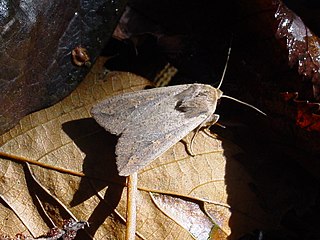
Mythimna unipuncta, the true armyworm moth, white-speck moth, common armyworm or rice armyworm, is a nocturnal agricultural pest belonging to the family Noctuidae. This moth is also commonly referred to by the scientific name Pseudaletia unipuncta. The species was first described by Adrian Hardy Haworth in 1809. Mythimna unipuncta is found in the Americas and in parts of Europe, Africa and Asia. Its original distribution is North and South America. It has been introduced to other places from there. They are known as armyworms because the caterpillars move in lines as a massive group, like an army, from field to field, damaging crops.

Hipparchia statilinus, the tree grayling, is a butterfly of the family Nymphalidae.

Chilo phragmitella is a species of moth of the family Crambidae, sometimes referred to by the vernacular names wainscot veneer or reed veneer. It was first described by Jacob Hübner between 1805 and 1810 as Tinea phragmitella, and is the type species of the genus Chilo.
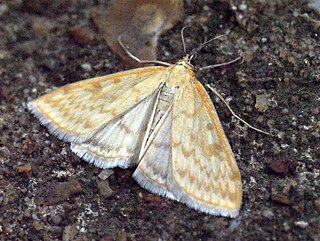
Sitochroa verticalis, common name lesser pearl, is a species of moth of the family Crambidae.
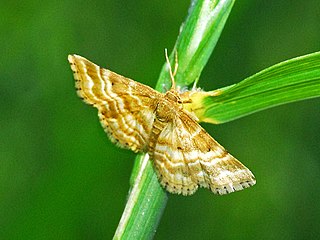
Emmiltis is a monotypic moth genus in the family Geometridae. Its only species is Emmiltis pygmaearia. Both the genus and species were first described by Jacob Hübner, the genus in 1825 and the species in 1809.

Leucania loreyi, the cosmopolitan, false army worm or nightfeeding rice armyworm, is a moth of the family Noctuidae. It is found in most of African countries, the Indo-Australian subtropics and tropics of India, Sri Lanka, Myanmar, the eastern Palearctic realm, and the Near East and Middle East. The species was first described by Philogène Auguste Joseph Duponchel in 1827.

The lunar-spotted pinion is a moth of the family Noctuidae.

Apamea rubrirena is a moth of the family Noctuidae.
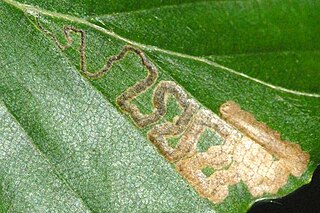
Stigmella tityrella is a moth of the family Nepticulidae. It is found in all of Europe, except the European part of Russia.

Xestia ochreago is a moth of the family Noctuidae.

The false water betony is a moth of the family Noctuidae. It is found from south-eastern France, through the Alps and bordering mountains east to Romania and Bulgaria. It is also found in Anatolia and Lebanon.

Aporophyla nigra, the black rustic, is a moth of the family Noctuidae. The species was first described by Adrian Hardy Haworth in 1809. It is found from North Africa, through southern and central Europe to Anatolia, in the north it is found up to Scotland and southern Norway. It is also found in the Caucasus, Israel and Lebanon.

Bembecia ichneumoniformis, the six-belted clearwing, is a moth of the family Sesiidae.
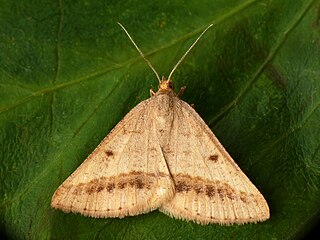
Isturgia arenacearia, the sand bordered bloom, is a moth of the family Geometridae. It was first described by Michael Denis and Ignaz Schiffermüller in 1775.
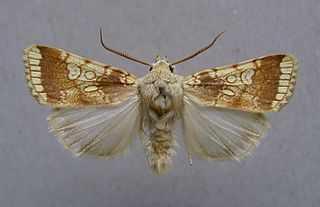
The heart moth is a species of moth of the family Noctuidae. It is found locally in Europe. It is also present in Turkey, Transcaucasia, the Caucasus, Israel, Iran and Iraq.

Scrobipalpa atriplicella, the goosefoot groundling moth, is a moth of the family Gelechiidae. It is found from most of Europe throughout Asia to Kamchatka and Japan. It is an introduced species in North America.

Eucosma cana, the hoary bell, is a species of moth of the family Tortricidae.

Hoplodrina superstes, also known as the powdered rustic, is a moth of the family Noctuidae, first described by Ferdinand Ochsenheimer in 1816. It is found in Asia and Europe.




















